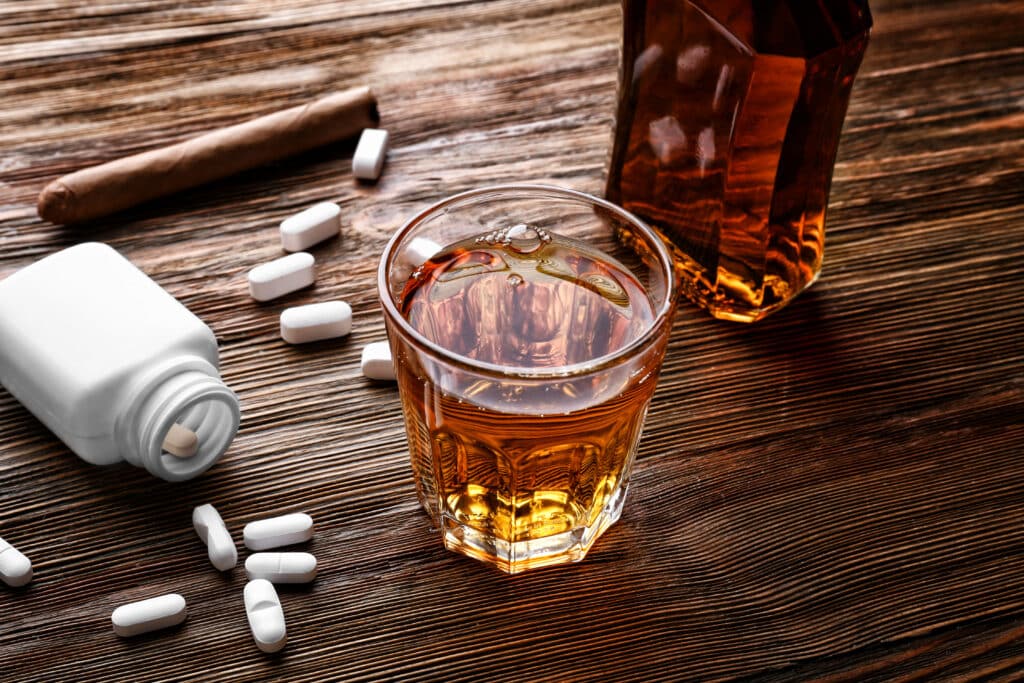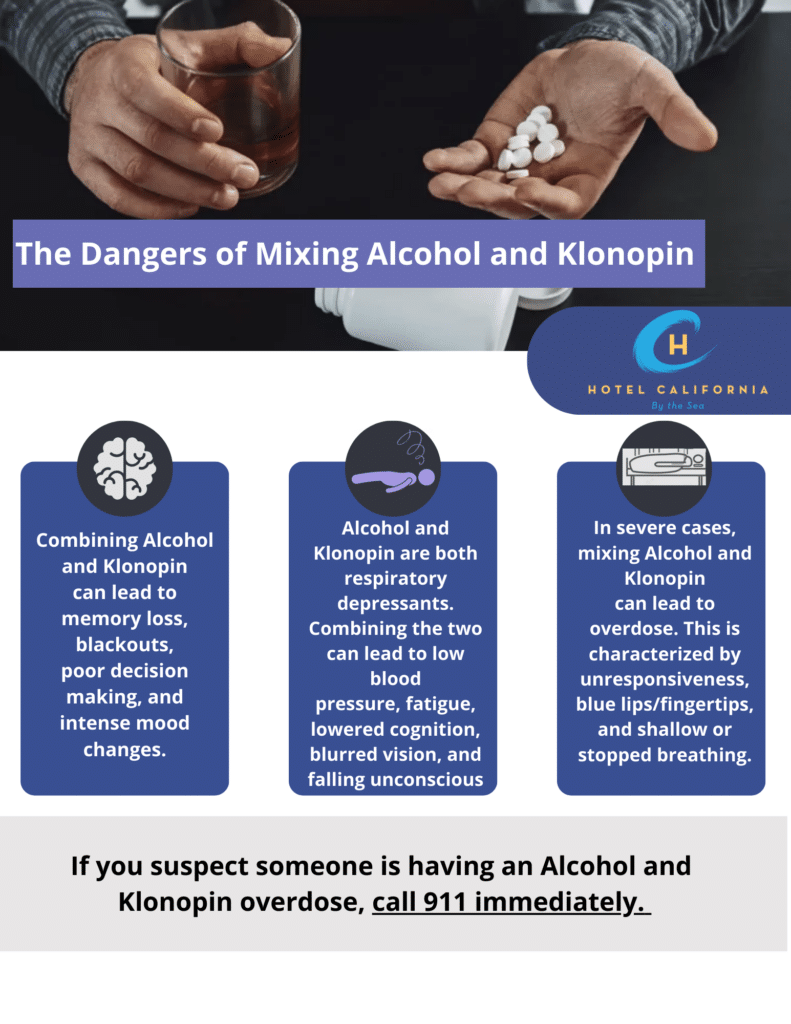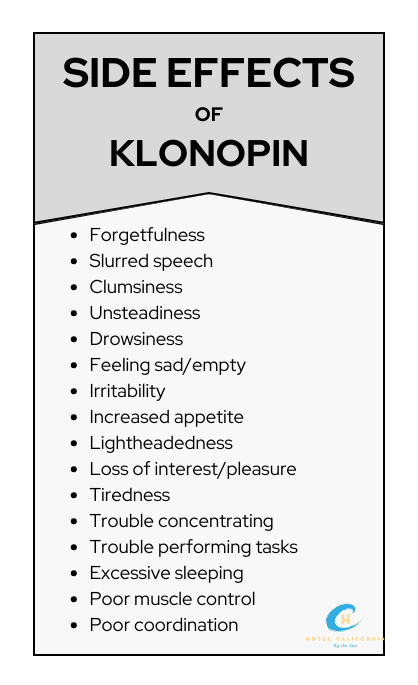What can happen when you mix Klonopin and Alcohol?
Klonopin is a popular prescription benzodiazepine drug in the US. It is used to treat generalized anxiety disorders, panic disorders and seizure disorders. Those who are on Klonopin are also known to abuse other substances such as alcohol. Both are central nervous system depressants and work to slow down activity in the brain and body. The combination of Klonopin and alcohol can heighten the effects of both substances and cause an unsafe level of respiratory depression and decreased heart rate. Both of those side effects can lead to overdose and death.

What is Klonopin?
Klonopin is a popularly prescribed drug. An estimated 15% of Americans have a bottle of benzos like Klonopin in the family medicine cabinet. Oftentimes, addictions can develop from using prescription medications per the recommendation of physicians.
Klonopin works by interacting with neurotransmitters in the brain called gamma aminobutyric acid (GABA). It is a GABA receptor agonist. Interactions with the GABA neurotransmitter can help reduce overactivity in the nervous system to produce a sense of calm. It slows down motor functions in the brain to provide relief from anxiety and seizures through increasing serotonin synthesis.
Klonopin has a half-life of about 30-40 hours. It takes about 5 half-lives for the drug to be completely processed and eliminated from the body. That is an estimated 5 days. The effects of the drug can last anywhere from 18-50 hours after the initial dose.
Side effects of the drug include vertigo, impaired cognition, confusion, slowed reaction time, impaired judgment and dizziness. In excess amounts, users can begin to experience hallucinations and develop worsening depression and adverse effects such as panic attacks.
The Schedule IV Controlled Substance is a long-acting and highly potent benzo. It has off-label uses for treating restless leg syndrome, acute mania, insomnia and tardive dyskinesia. It is also commonly prescribed to help treat symptoms of alcohol use disorder. In these cases, Klonopin is given to patients during the detox phase to help ease uncomfortable withdrawal symptoms.

What is Alcohol?
Alcohol is a popular depressant that also works to slow down brain activity by interrupting the brain communication pathway. When alcohol use becomes more frequent, this can lead to tolerance and dependence. Alcohol use disorder is the inability to stop drinking despite repeated negative consequences that occur due to alcohol use. Alcohol abuse can cause both physical and psychological damage. The most common side effects include difficulty with basic motor skills, slurred speech, poor coordination and even changes in behavior and personality.
Together, Klonopin and alcohol can produce intense sedative effects. Benzos such as Klonopin, along with alcohol, is one of the most commonly abused drug combinations. This leads to a high risk of overdose as well as experiencing adverse side effects of one or both substances. Mixing any medication with alcohol can increase the chances of experiencing negative and heightened side effects.

Side Effects of Klonopin and Alcohol
- Drowsiness and excessive sedation
- Dizziness
- Increased risk for overdose – slurred speech, extreme sedation, reduced attention span and lack of coordination
- Increased risk of coma – the depressant combination can lead to extreme sedation into the state of unconsciousness and they are unable to respond to stimuli
- Respiratory depression – slowed or difficulty breathing can prevent the brain from getting enough oxygen resulting in coma and death
- Impaired motor control and decreased coordination
- Unusual changes in mood and behavior – inability to control emotions and increased thoughts of suicide
- Impaired memory
- Increased tolerance for one or both substances
- Nausea and vomiting
- Increased risk of confusion – the combination of drugs can affect how the brain communicates and can cause confusion when the user does not understand their surroundings
- High risk of heart attack and stroke
- Risk of developing psychosis – users face an increased risk of mental confusion and paranoia
- Reduced inhibitions – this can lead to an increased chance of engaging in dangerous behaviors
- Seizures
- Gastrointestinal issues
- High risk of tolerance, dependence and addiction
Check Your Insurance Coverage for FREE
Find out if your insurance covers addiction treatment in minutes. We accept most insurance!
The combination of Klonopin and alcohol can heavily impact the liver. Klonopin is broken down and processed in the liver. In excess amounts, the liver will be unable to properly perform its duties causing a toxic build-up of Klonopin in the body. This makes it more difficult for the liver to process the drug chemicals and can raise the risk of negative side effects.
Those who abuse alcohol also develop liver damage. Alcoholic liver cirrhosis and fatty liver disease are common side effects of alcohol abuse. When taken together, both drugs cause massive amounts of pressure on the liver and its performance. The liver will be unable to keep up with the substance intake causing damage and breakdown of proper liver functions.
Risk factors for developing a Klonopin and Alcohol Addiction
- Family history of substance abuse and alcohol abuse
- History of trauma
- History of other mental health and co-occurring conditions
- Social and cultural factors
- Environmental factors
Reach out to Hotel California by the Sea
We specialize in treating addiction and other co-occurring disorders, such as PTSD. Our Admissions specialists are available to walk you through the best options for treating your addiction.
Treatment of Klonopin and Alcohol Addiction
The combination of Klonopin and alcohol can lead to dangerous consequences. It can lead to an addiction to one or both substances. Behavioral treatment programs such as Hotel California by the Sea provide professional and effective substance and alcohol addiction treatment.
The substance use disorder and alcohol use disorder program at Hotel California by the Sea provides all levels of care including detox, residential and outpatient treatment. Our substance and alcohol detox provides medication-assisted treatments as well as long-term medication treatments after the detox phase has been completed. Our residential program provides intensive therapies in combination with any medication treatments. And in our outpatient programs PHP and IOP, clients will continue therapies as well as participate in our career education program and other addiction recovery support groups.
We offer evidence-based treatments such as CBT, DBT and EMDR therapy. Cognitive behavioral therapy and dialectical behavioral therapy help clients understand the underlying root cause of their addiction. EMDR therapy helps the client learn and practice effective coping skills to help them manage distressing feelings associated with their addiction.
Through individualized treatment care, career and family resources, and a clinical and peer support group, clients will be able to overcome their addiction and live a healthier life in sobriety.
References
https://www.ncbi.nlm.nih.gov/books/NBK556010/
https://vertavahealth.com/polysubstances/klonopin-alcohol/
https://vertavahealth.com/polysubstances/alcohol-clonazepam/
https://www.choosingtherapy.com/klonopin-and-alcohol/
https://www.addictioncenter.com/alcohol/
https://www.eleanorhealth.com/blog/alcohol-and-benzos
https://www.medicalnewstoday.com/articles/drugs-klonopin-interactions
https://www.addictioncenter.com/benzodiazepines/klonopin/
https://www.healthline.com/health/drugs/klonopin-interactions
